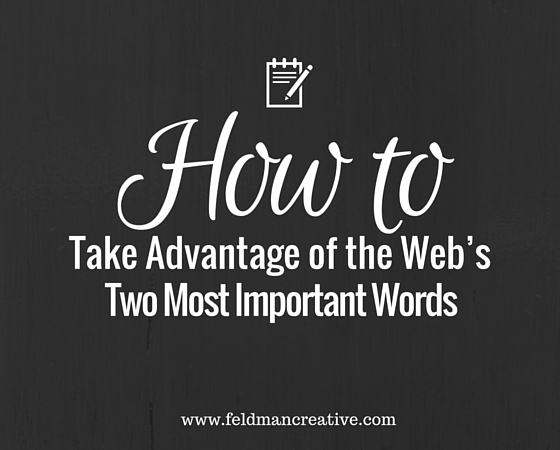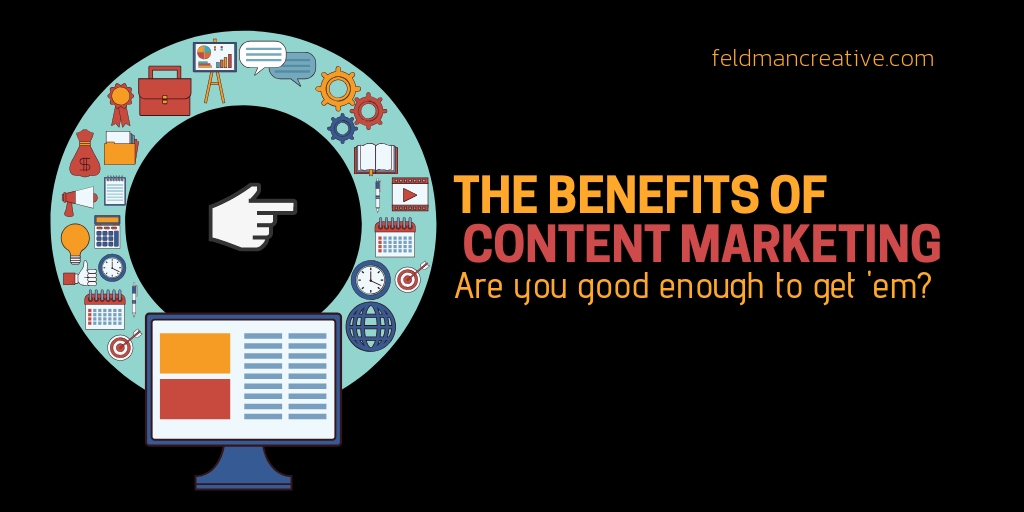Two words: how to. Simple. Effective. Foolproof. Timeless.
“How to” are the two most important words on the web. Experienced writers know it. Now you do too.
Should every headline begin with “how to?”
No. That’d be boring as the Celine Dion catalog.
Should every business blog include how-to articles?
Yes. Some blogs use the technique in practically every post. Again, snoozeville. Some bloggers purposely avoid the “how to” headline. They find it too cliché. Big mistake. Here’s the thing about clichés: people get ‘em.
You can make every post title include “how to” or never type the two words your entire publishing career. Doesn’t matter.
What does matter is your blog posts, web pages, infographics, podcasts, videos, SlideShares, and every friggen helping of content you serve should serve your audience. The sooner you start applying this principle, the sooner you’ll have an audience.
You can serve your audience in multiple ways, but the most effective way is to answer their questions. Google gave us the Q&A Epicenter of the World. It’s every business’s FAQ page (or at least it can be).
My point is the most effective content you’re going to create will provide how-to lessons.
I shall show you the proof
I only occasionally do the here’s-what-you-might-have-missed-on-my-blog type of post. It seems a bit too self-serving (though it may be just the opposite).
Essentially, it’s indexing. The more you index stuff on your website, the more you:
- Help your readers find useful content
- Increase time-on-site and engagement (aka stickiness, an old, but cool web term)
- Deliver search engines the relevance indicators they need
Anyhooo… Like every content marketer should, I was analyzing page views on my blog for this year and its entire history in an effort to determine the topics and pieces that have been the best received. If you don’t do this periodically, I recommend you start.
While doing the exercise it occurred to me, (1) I want to do a “greatest hits” post and (2) I want the post to become a “how to.”
So I’m about to show you the posts, invite you to read and share them, explain how each is in fact a “how to,” and finally, I hope, give you ideas about how you can publish “how to’s” using various headline writing styles.
Feldman Creative’s top 5 posts this year are how to’s
How to Find Keywords People Use (But Your Competitor’s Don’t)
Clearly I don’t need to explain the point of the post or how I used the “how to” approach. I will point out tagging a parenthetical phrase onto your headline is often effective.
What Social Media Tactics Are Most Effective?
This is a list post, but I decided to go with the question technique. The headline clearly plants a seed the content will explain how to employ highly effective social media tactics. BTW, the post landed on page one of search for several keyword variations and collects new backlinks daily.
SEO Bullshit (And How to Avoid Stepping In It)
A little shock value and an obvious variation of a “how to” headline in which I use the words, but don’t begin with them. (And further proof I’m keen on parentheses.) BTW, it ranks first. If it’s “SEO bullshit” you’re looking for, I’m your man.
Eye-Popping, Reader-Stopping. Social Media-Rocking Visual Marketing
You might say the title implies a how-to on visual marketing. You might say “pop, stop, and rock” are three how-to’s. Or you might say I just wanted to write a fun, reader-stopping headline (and you’d be right). You should look at this post if only to see my shamelessly goofy attempt to create an eye-popping hero shot.
100 Ways Your Company Loses to Better Online Marketers
How to increase the effectiveness of your online marketing is the point here. I believe the post’s title provides an example of how a list post can map to the how to approach.
Feldman Creative’s top 5 posts of all-time are how-to’s
Enlarge Your Digital Footprint for More Effective Online Marketing
Here’s another way to craft an effective headline of the how to variety. Write the headline first as “How to (fill in the blank).” After, remove the “how to.” You can see how I’ve done that here in what is my most viewed post of all time (with a big assist from this “best of” post on Social Media Examiner). Notice too how I’ve managed to get a “what” and “why” (benefit statement) in the title.
SEO Simplified for Short Attention Spans
This headline could have easily been “How to Learn SEO Basics Fast” and I considered it. However, the post was inspired by a client asking me to deliver an SEO lesson in 15 minutes, so I took a little chance with the “Short Attention Spans” as a way of qualifying the reader. It worked. This post ranks in the top spot for “SEO Simplified” and is my most shared post.
The Most Important Thing You Need to Know About Infographics
This post is partially a “how to.” It explains how to create an infographic. I suppose there’s no lesson here on creating variations of a “how to.” Instead, the headline is a form of the “Why” style, which is also tremendously powerful.
Email Marketing: Why You Need It and How to Nail It
I’ve wondered if I actually did “nail it” with this headline, but it ranks as my fourth most popular post, so the combination of “how” and “why” appears to have worked. Note the Subject-Colon-Second Part (Subject: More Words) style employed here, also a proven winner and a popular SEO strategy. This deep and highly instructive post was repurposed as an eBook where the title is a more standard how to: Email Marketing: How to Master the Most Effective Media Tool of All.
The Most Effective Content Marketing Tip Ever
This one’s not really a “how to,” is it? Its content actually is and it could have been titled, “How to Get Started with Content Marketing.” I chose to give it the big superlative approach instead, which you might try. Be careful though. Don’t do it if you can’t deliver.
Ultimately, with or without the magnetic words, “how to,” an effective headline or title is a promise to the reader. You have to make good on your promise.
I hope I’ve inspired you to read some of these popular posts if you’ve missed them. And more importantly, I hope to have taught you the power of the “how to” approach to headline writing and given you some ideas how to pull it off in interesting ways.




![How to Write Powerful Headlines for Your Online Content [Infographic] How to Write Powerful Headlines for Your Online Content [Infographic]](https://feldmancreative.com/wp-content/uploads/2019/04/Screen-Shot-2019-04-19-at-5.38.54-PM.png)


Comments
Sue-Ann Bubacz
This has some great examples of using how to without the how to! I think your titles are always interesting but this explains how you seem to go against the usual but accomplish the task in your headlines at the same time…hmmm…more good stuff, so thanks Barry:) Sue-Ann
Max
Brilliant.
Max
Purely Brilliant.